英汉礼貌用语对比研究-文学学士毕业论文
- 格式:doc
- 大小:97.50 KB
- 文档页数:14

本科生毕业论文(设计)题目:Comparison of English and Chinese EuphemismBased on the Politeness Principle从礼貌原则上看中西委婉语的差异系别:外国语言文学系专业:英语AbstractAlong with the continuous development of globalization, the communications between China and western countries have been increasing gradually in economy, politics and culture. More and more of us are required to understand people coming from countries and cultures different from our own, so the impact of difference between Oriental and Occidental cultures on international trade becomes increasingly exposed. In the cross-culture communication, we can not be ignorant of the differences between English and Chinese euphemism.In addition, p oliteness is the symbol of human culture and society’s universal phenomenon. However, the different cultures has different politeness principle which does not use to weigh the standard as well as the expression way. Learning the different usages of English and Chinese euphemisms based on the politeness principle aims at pointing out that people can put the euphemisms into right usage only if people understand correctly different cultures. Only in this way, we can avoid some mistakes, misunderstanding or even conflicts. Thus, we can promote the cross-cultural communication going effectively and to be in the best condition.This paper aims at discussing the differences between English and Chinese euphemisms that are faced in today's international communication and evolving appropriate measures to deal with those. It consists of four parts, with an introduction and a conclusion preceding and following them. As euphemism is a linguistic phenomenon, chapter two first states the origin and the definition of the euphemism, and the analysis of the obedience of the English and Chinese politeness principle, thus building up a better understanding of euphemism. Chapter three illustrates the differences of English and Chinese euphemism and discusses the factor forthe differences. All of these can help people to avoid pragmatic failures in communication.Key Words: Euphemism,Politeness Principle,Contrastive Analysis毕业设计(论文)原创性声明和使用授权说明原创性声明本人郑重承诺:所呈交的毕业设计(论文),是我个人在指导教师的指导下进行的研究工作及取得的成果。
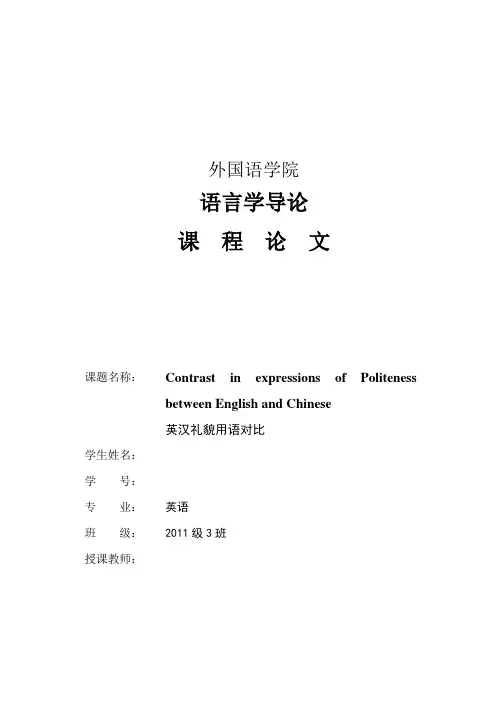
外国语学院语言学导论课程论文课题名称:Contrast in expressions of Politeness between English and Chinese英汉礼貌用语对比学生姓名:学号:专业:英语班级:2011级3班授课教师:AbstractIn intercultural communication, people always are faced with difficulties not only from using different languages but also from different cultural backgrounds. These language barriers often lead to unsuccessful communication. In order for favoring communication, this article will discuss the contrast between English and Chinese politeness principle as well as the communication barriers due to language differences. Key wordsPoliteness, Cultural differences, Intercultural communication1.IntroductionCommunication is the mutual contact between people, and the connection with each other's behavior. Where there are people, where there is human interaction. And at the same time, contact will occur, communicative. People can use language or non-verbal language to express ideas or share feelings. However, this communication process is very complex. People's verbal communication is always influenced by many non-linguistic factors.In the cross-cultural communication of English speakers and Chinese speakers, communication isn’t often smooth, because the two sides do not understand their cultural background. For better communication, British linguist Leach made the famous "Politeness Principle".As a universal phenomenon in all societies, politeness is what people of different cultural backgrounds all try to observe for the purpose of increasing communicative competence. Being an important element in intercultural communication, politeness helps establish, maintain or consolidate harmonious interpersonal relationships, and reduces conflicts and misunderstandings. Therefore, principles of politeness in different cultures should be realized by students. This thesis intends to discuss the exhibition of cultural differences on politeness to help Chinese learners have a better understanding of different principles of politeness in English. Besides, this paper is to explore efficient means to teach students to use English in the polite way in order tocommunicate effectively and efficiently.2.Contrast in expressions of Politeness between English andChineseCultural differences in everyday conversation refer to the differences in habits and rules in communication between different cultures (Liang Jinghong, 2005). Customs are influenced and shaped by the beliefs and values of people in a certain community. People are brought up in community and they are so accustomed to their ways of doing things that they cannot accept different actions for achieving the same goal. Therefore, in this part, differences of politeness such as addressing, greeting, complimenting between English and Chinese are to be discussed.2.1Communicating TopicsIn Chinese culture, between colleagues, between students, between friends almost all kinds of topics are reasonable in talking, such as work, health, salary, marriage, age and so on. However, in English-speaking countries, people often just talk about the weather, work, hobbies and other topics. It also can be more free and open to talk about pregnancy and even sex. But some topic on marital status, children, income, religion and others which belong to the "privacy content" should be ignored. When Chinese people express concern for the health of others, they often ask the health condition of others straightly and make some advisory recommendations. While in English-speaking countries, when people ask the health condition, the tone should be tactful and sincere. When the other does not need you to give your advice, do not put forward proposals.2.2AddressingName is the address form which communication is relied on. Different languages have different address forms. The address forms can reflect different national cultures. Chinese attaches great importance to human kinship. Respect is very essential in Chinese culture. When younger people address the elders, they should call them "grandfather", "grandmother" and other titles to replace their name, not by their name. The same situation with calling teachers, students in China must call them “teacher”, that is sir or madam. But in western countries, teachers can be called by their names. Terms of family relationshipsare only used for relatives in English. But in Chinese, they are not only used for relatives, but also for non-relatives. For example, the young in China always call the women who are elder than them “sister” or “aunt” and those men “brother” or “uncle”.2.3 Greeting and FarewellGreetings are used every day, but they are not conducted in the same way in different cultures. When westerners meet an acquaintance, they often greet each other with “Hello”, “Hi”, or “How are you?” But a Chinese will say “chi le ma?” (Have you eaten?), or “qu na li ?” (Where are you going?). When a native English speaker hears those, he or she may interpret it as an invitation to dinner or interference in his or her personal affairs. So when interacting with foreigners, Chinese should pay more attention. In English, the common ways of greeting are “Good morning”, “Hi”, “Hello”, “How are you?”, and “How is everything going?”When acquaintances part, the English speakers may say “Goodbye”, “See you”, and “Good luck”. Differently,in Chinese, when a guest leaves, the host will show the guest to th e door and say “man zou” (Walk slowly.), “zou hao” (Take care.), or “yi lu shun feng” (Have a nice trip.). But none of these can be directly translated into English.2.4Compliments and ResponsesIn cross-cultural communication, since English speakers and Chinese speakers have different politeness principle to praise or compliment, communicative disorders produce inevitably. Expressions such as “hen hao, bu cuo, hen bang” in Chinese are often used, which mean “great, good, terrific” in English. However, there d o exist some cultural differences in compliments between English and Chinese. One difference lies in who can be complimented. It is usual for an American woman to praise her husband, talking about how hard he works and how well he has done. She might do the same about a son or a daughter of hers. In the English-speaking countries, one can praise one’s family members. But we Chinese people seldom compliment our family members in front of others. The Chinese are polite rather than honest while the westerners tend to be frank and direct. The other difference lies in what can be complimented. It is quite common for a male English speaker to compliment females on her good looks. But in China, praising a man on his wife’s looks will be regarded as indecent, and ev en a taboo. When responding tocompliments, westerners tend to accept the compliments naturally by saying “Thank you!” In contrast, Chinese generally murmur something implying that he or she is not worthy of the praise in order to show modesty, because modesty is considered as a kind of traditional virtue. In China, modesty is the best policy, but to westerners, honesty is the best policy (Luo Ningxia, 2000).2.5 ApologiesBoth Chinese and English have expressions for apologies. For example, there are “dui bu qi”, “bao qian”, “hen yi han”in Chinese and “I am sorry”, and “Excuse me” in English. But generally speaking, English speakers apologize more often than the Chinese people by saying “Excuse me” preceding a request or an interruption. When they want to push their way out of the crowd, leave a dinning table to the toilet, stop a stranger to ask for direction, and even when they need to answer the phone, they would usually say this. But in China, “dui bu qi”, “hen yi han” are very often used only when they feel sympathetic or when they need to bother others. In English, “Excuse me” can also be heard when someone sneezes or hiccups. This is quite different from Chinese culture.2.6 TaboosTaboo expressions exist in nearly all cultures, and inappropriate use of taboo language will cause obstacles in communication. Expressions concerning some phenomenon are considered as taboos in both Chinese and English cultures such as human’s excreta and death. But generally speaking, there are more taboos in English than in Chinese. English-speaking people place a higher value on privacy. Therefore, some topics would be considered as privacy and it is impolite to mention these topics. For instance, asking others about age, especially a woman’s age, is regarded as impolite in western cultures. Besides age, other topics such as income, marital status, and religion are also sensitive topics which may likely cause offense. Chinese sometimes talk about health and express their concern by giving some advice such as “Have a rest.”,“Put on more clothes and drink more water.” However, English speakers will feel uncomfortable on hearing these words. According to English culture, they are independent adults and are supposed to be able to take care of themselves. Such expressions as “Put on more clothes” seem to deny their ability of taking care of themselves. On this occasion, expressions such as “Look after yourself.”, “Hopeyou will be better soon.” sound better to them.3ConclusionIn summary, politeness is a social phenomenon, and generally exist in a variety of languages. Different cultures have different standards of politeness and expression. In cross-cultural communication, the students should try to avoid misunderstanding of courtesy, make relationships closer, and promote communication between people with different cultures. Teachers in English teaching should seize the opportunity to import the culture of English-speaking countries to the students. It is hoped that English learners will attach great importance to the communicative functions of the target language so that they will realize the importance of using polite language appropriately, and then their pragmatic competence of target language will be greatly improved.This paper does not aim to cover all aspects of politeness in EFL teaching. Its ideas and arguments are far from mature. But it is our sincere hope that through a careful study of politeness in FL classroom, we can achieve a more effective teaching and improve students’ communicative competence.BibliographyBrown, P. & S, Levinson. (1978). Politeness: Some Universals in Language Usage. Cambridge: Cambridge UniversityPress.Gu, Yueguo. (1990). Politeness phenomena in modern Chinese. Journal of Pragmatics, (2), 237-257.Hinkel, E. (1999). Culture in Second Language Teaching and Learning. Cambridge: Cambridge University Press.Leech, G. (1983). Principles of pragmatics. London: Longman.Swan, M. (1980). Practical English Usage. London: Oxford University Press.。
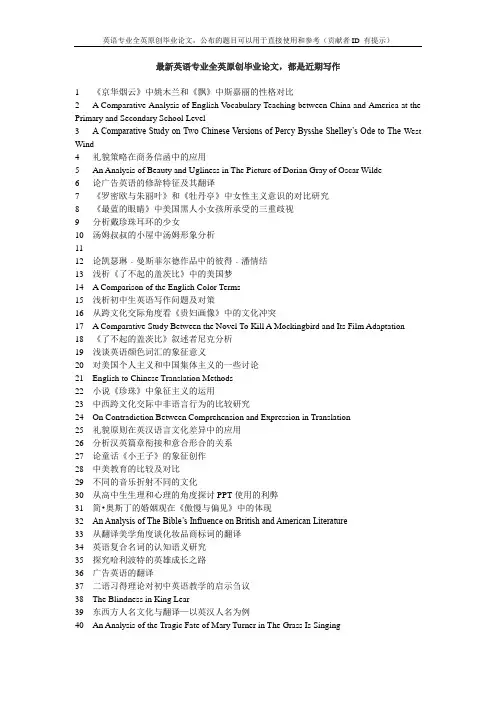
最新英语专业全英原创毕业论文,都是近期写作1 《京华烟云》中姚木兰和《飘》中斯嘉丽的性格对比2 A Comparative Analysis of English V ocabulary Teaching between China and America at the Primary and Secondary School Level3 A Comparative Study on Two Chinese Versions of Percy Bysshe Shelley’s Ode to The West Wind4 礼貌策略在商务信函中的应用5 An Analysis of Beauty and Ugliness in The Picture of Dorian Gray of Oscar Wilde6 论广告英语的修辞特征及其翻译7 《罗密欧与朱丽叶》和《牡丹亭》中女性主义意识的对比研究8 《最蓝的眼睛》中美国黑人小女孩所承受的三重歧视9 分析戴珍珠耳环的少女10 汤姆叔叔的小屋中汤姆形象分析1112 论凯瑟琳﹒曼斯菲尔德作品中的彼得﹒潘情结13 浅析《了不起的盖茨比》中的美国梦14 A Comparison of the English Color Terms15 浅析初中生英语写作问题及对策16 从跨文化交际角度看《贵妇画像》中的文化冲突17 A Comparative Study Between the Novel To Kill A Mockingbird and Its Film Adaptation18 《了不起的盖茨比》叙述者尼克分析19 浅谈英语颜色词汇的象征意义20 对美国个人主义和中国集体主义的一些讨论21 English to Chinese Translation Methods22 小说《珍珠》中象征主义的运用23 中西跨文化交际中非语言行为的比较研究24 On Contradiction Between Comprehension and Expression in Translation25 礼貌原则在英汉语言文化差异中的应用26 分析汉英篇章衔接和意合形合的关系27 论童话《小王子》的象征创作28 中美教育的比较及对比29 不同的音乐折射不同的文化30 从高中生生理和心理的角度探讨PPT使用的利弊31 简•奥斯丁的婚姻观在《傲慢与偏见》中的体现32 An Analysis of The Bible’s Influence on British and American Literature33 从翻译美学角度谈化妆品商标词的翻译34 英语复合名词的认知语义研究35 探究哈利波特的英雄成长之路36 广告英语的翻译37 二语习得理论对初中英语教学的启示刍议38 The Blindness in King Lear39 东西方人名文化与翻译—以英汉人名为例40 An Analysis of the Tragic Fate of Mary Turner in The Grass Is Singing41 高中英语写作作业的反馈及实施效果42 英汉味觉词“酸甜苦辣”的比较分析43 欧•亨利短篇小说的特点44 如何提高小学生对英语学习的兴趣45 外交辞令中模糊语言的语用分析46 从思维方式看中英科普文章的差异47 英语听力理解障碍及应对策略48 浅谈在华跨国公司的本土化策略49 Influences of Chinese Classical Poetry on Ezra Pound50 现代信息技术与英语学科教学的有效整合51 剖析简•爱性格的弱点52 Comparison of models of Human Resource Management between East and West53 从“进步”话语解读《苔丝》中环境因素与人物性格54 从莎翁作品透视伊丽莎白时期女性社会地位55 英汉禁忌语的对比分析56 从《了不起的盖茨比》看美国梦的幻灭57 《圣经》对英语习语的影响58 《圣经》与人类文明起源59 英汉恐惧隐喻对比研究60 英语财经报道中的词汇衔接研究61 勃朗特两姐妹创作风格差异探究62 从《通往雨山之路》看美国印第安文化的逐渐衰落63 从语用学角度对英语课堂中委婉语的使用探究64 批评与重新解读《日瓦戈医生》65 英汉动物习语内涵意义的文化差异66 中英语言中动物词汇的文化含义对比67 浅析英语粘着词素及其在词汇教学中的实用价值68 On“Faithfulness, Expressiveness, Elegance” in Translation of Business Contract69 Terror of the Soul-An alysis of Features in Poe’s Gothic Fictions70 浅析英语谚语中的女性歧视71 论《荆棘鸟》中人性和宗教信仰的矛盾冲突72 A Comparison of the English Color Terms73 从合作原则角度简要分析《老友记》中乔伊的性格特征74 英汉委婉语中体现的文化异同75 英汉数字习语的翻译76 初中英语教学中的角色扮演77 英语汉源借词研究78 林黛玉和简.爱不同命运的对比79 从电视相亲节目看当代中美女性婚恋观差异80 简爱的独立与反叛性格分析81 从《红字》看霍桑对清教主义的批判与妥协82 从约翰邓恩的“奇思妙喻”中透视他矛盾的情感观83 论隐喻的本质与功能84 英语动画片中的中国元素探究85 中西方新闻报道看道德观差异86 论地理位置对中美民族性格的影响87 华裔美国文学中的幽灵叙事探析88 Reconstruction of Black Identity in Toni Morrison’s Beloved89 《永别了,武器》的意象分析90 礼貌原则在英语商务信函中的运用91 歇斯底里的舞台自语者——《寻找格林先生》主题解读92 论修辞在英语广告中的应用93 社会因素对汉语中英语外来词的影响94 Domestication and Foreignization in Idioms Translation95 《道连葛雷的画像》叙事艺术的分析96 从语言角度分析《功夫熊猫》中中西文化的交融97 从英汉习语视角看中英文化差异98 简爱中的批判现实主义和浪漫主义99 传统教法与交际法结合的英语教学探讨100 沃尔玛策略研究101 解析凯瑟琳的爱情与婚姻之分离102 从《印度之行》看福斯特的人文主义思想观103 企业网络营销策略分析104 英汉禁忌语对比研究105 跨文化交际中的语用失误及其对策106 安吉尔的精神悲剧—分析哈代笔下人物的心理发展过程107 词汇教学法在中学英语教学实践中的应用108 从关联理论看《阿甘正传》的字幕翻译109 论《被遗弃的韦瑟罗尔奶奶》中象征主义和意识流的运用110 《紫色》中的女性主义解读111 The Pervasive Agitation of Humbert in Lolita112 《等待戈多》中的矛盾分析-分裂的语言与互补的人物113 语用策略在英语商务信函中的应用114 中英文新闻标题的差异115 《哈克贝利•费恩历险记》的艺术特色分析116 中西方家庭教育对比研究——从《傅雷家书》和《致儿家书》的对比117 从目的论角度分析化妆品品牌翻译118 从目的论角度分析商业电视广告中双关语的翻译119 古诗词英译关于夸张的翻译策略研究120 从功能翻译理论看汉语公示语的英译121 《呼啸山庄》男主人公希斯克里夫的性格分析122 伯莎梅森形象分析123 浅析亨利•詹姆斯小说《螺丝在拧紧》中的哥特成分124 苔丝悲剧的原因与托马斯哈代悲剧意识的分析125 On C-E Translation of Neologisms from the Perspective of Nida’s Functional Equivalence Theory126 英汉基本颜色词的文化差异及其翻译策略127 从文化差异的四维度读解中法葡萄酒文化128 Angel’s Face, Devil’s Heart—The Degeneration of Dorian Gray in The Picture of Dorian Gray129 谈电影片名的翻译130 《夜访吸血鬼》中的模糊性别观131 Irony Art in Orwell’s Animal Farm132 An Analysis on Shear's Personality in The Bridge on the River Kwai133 A Comparative Analysis of Vanity Fair and Great Expectations134 浅析田纳西•威廉斯剧作《欲望号街车》的同性恋倾向135 浅析《了不起的盖茨比》中的主要人物性格136 多元智力发展与外语教学137 《诗经》与《圣经•雅歌》中爱情诗的比较研究138 互动在高中英语阅读课的应用139 论《觉醒》中艾德娜女性意识的觉醒140 A Feminist Reading of Virginia Woolf and A Room of One’s Own141 初中英语词汇教学法研究综述142 论《喧哗与躁动》中的女性形象143 试析中英婚姻生活差异及其原因144 广告英语及其翻译145 Application of Foregrounding Theory to Translation of Simile and Metaphor146 On Feminism in Persuasion147 《老人与海》的主题解析148 浅析《看不见的人》中看得见的种族歧视149 商务英语翻译中的隐喻研究150 英语广告语篇中名物化的研究151 福克纳小说《献给艾米莉的玫瑰》的叙事技巧研究152 中餐菜谱翻译的错误分析153 浅论广告英语的修辞特色154 《罗密欧与朱丽叶》中双关语的研究155 《达洛卫夫人》与弗吉尼亚•伍尔夫的女性主义156 论视觉小说中的西方神话形象重塑——以《命运之夜》系列为例157 从浪漫主义角度剖析《海上钢琴师》在中国流行的原因158 中英爱情隐喻的对比研究159 从归化与异化之争看四字格的运用160 从模因论视角看年度流行语“给力”161 高中英语反思式教学研究162 斯佳丽,在逆境中成长163 英汉恭维语的对比研究164 《了不起的盖茨比》中的象征主义解读165 论《老人与海》中圣地亚哥性格的双重性166 中西方节日文化差异研究167 山寨文化的反思——发展与创新168 浅议创新型口语教学在农村中的实施169 试论英语词汇教学中的词块教学170 论中美商务沟通中的跨文化意识171 霍桑在《红字》中对人的罪恶的探究172 The English Translating of Chinese Neologisms in Political Documentation: Methods and Strategies173 哥特元素在《宠儿》中的运用174 《查特莱夫人的情人》中肉体与灵魂的平衡175 化学专业学生英语阅读策略研究176 八十年代以来汉语中英语外来语及翻译177 浅谈电影台词的翻译技巧--以《追求幸福》为例178 文化语境对中西商务谈判的影响179 谈《傲慢与偏见》中伊丽莎白的女性主体意识180 A Summary of Symbols of The Scarlet Letter181 小学英语语音拼读教学182 中国时政新词翻译探析183 论《紫色》中西莉的精神意识的创建184 论《麦田里的守望者》的意义185 从《生活的艺术》看林语堂的人生艺术186 Culture-based Strategies in Translating Ancient Chinese Official Titles187 浅析《傲慢与偏见》中伊丽莎白的性格和婚姻观188 商务英语函电的语言和文体特征及其翻译189 从模因论角度研究中文新闻标题中的流行语190 中西礼貌用语的语用对比研究191 从翻译美学角度谈汽车商标词的汉译192 报刊英语新词的汉译193 Advertising Language: A Mirror of American Value194 生存危机和渴求改变——黑色幽默小说的主体研究195 简与林黛玉性格及命运对比196 苔丝悲剧人生的起因197 文化背景知识在英语教学中的作用198 以学生为中心的英语词汇教学研究199 <<罗伯特家的苔丝>>中动植物的作用200 英美小说《傲慢与偏见》和《飘》中的女性主体意识比较分析。
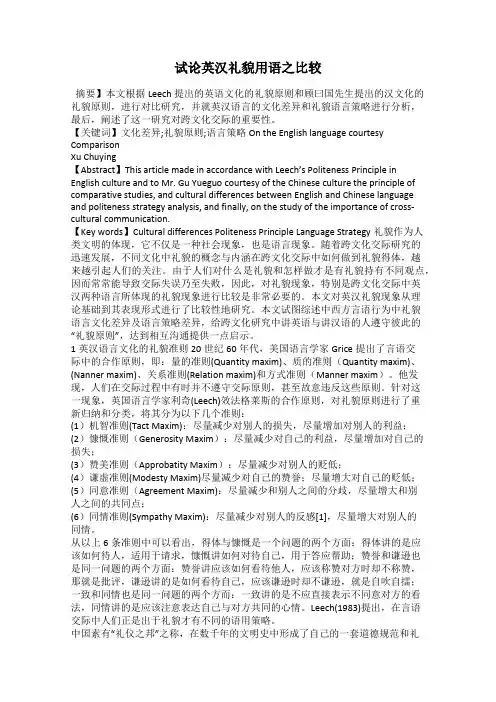
试论英汉礼貌用语之比较摘要】本文根据Leech提出的英语文化的礼貌原则和顾曰国先生提出的汉文化的礼貌原则,进行对比研究,并就英汉语言的文化差异和礼貌语言策略进行分析,最后,阐述了这一研究对跨文化交际的重要性。
【关键词】文化差异;礼貌原则;语言策略On the English language courtesy ComparisonXu Chuying【Abstract】This article made in accordance with Leech’s Politeness Principle in English culture and to Mr. Gu Yueguo courtesy of the Chinese culture the principle of comparative studies, and cultural differences between English and Chinese language and politeness strategy analysis, and finally, on the study of the importance of cross-cultural communication.【Key words】Cultural differences Politeness Principle Language Strategy礼貌作为人类文明的体现,它不仅是一种社会现象,也是语言现象。
随着跨文化交际研究的迅速发展,不同文化中礼貌的概念与内涵在跨文化交际中如何做到礼貌得体,越来越引起人们的关注。
由于人们对什么是礼貌和怎样做才是有礼貌持有不同观点,因而常常能导致交际失误乃至失败,因此,对礼貌现象,特别是跨文化交际中英汉两种语言所体现的礼貌现象进行比较是非常必要的。
本文对英汉礼貌现象从理论基础到其表现形式进行了比较性地研究。
本文试图综述中西方言语行为中礼貌语言文化差异及语言策略差异,给跨文化研究中讲英语与讲汉语的人遵守彼此的“礼貌原则”,达到相互沟通提供一点启示。
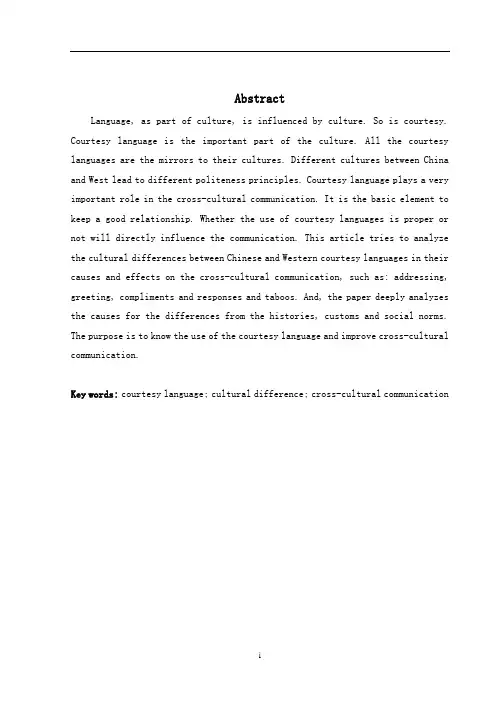
AbstractLanguage, as part of culture, is influenced by culture. So is courtesy. Courtesy language is the important part of the culture. All the courtesy languages are the mirrors to their cultures. Different cultures between China and West lead to different politeness principles. Courtesy language plays a very important role in the cross-cultural communication. It is the basic element to keep a good relationship. Whether the use of courtesy languages is proper or not will directly influence the communication. This article tries to analyze the cultural differences between Chinese and Western courtesy languages in their causes and effects on the cross-cultural communication, such as: addressing, greeting, compliments and responses and taboos. And, the paper deeply analyzes the causes for the differences from the histories, customs and social norms. The purpose is to know the use of the courtesy language and improve cross-cultural communication.Key words: courtesy language; cultural difference; cross-cultural communication摘要语言既是文化的载体,又是文化的一部分,语言受到文化的影响,是文化的一面镜子。
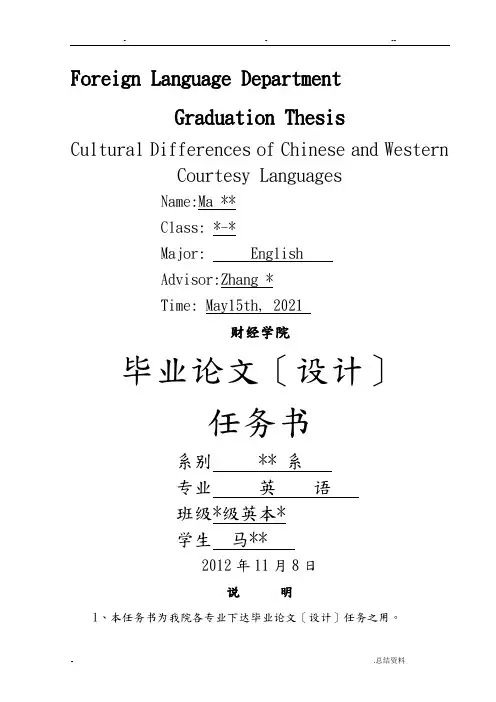
- - -- Foreign Language DepartmentGraduation ThesisCultural Differences of Chinese and WesternCourtesy LanguagesName:Ma **Class: *-*Major: EnglishAdvisor:Zhang *Time: May15th, 2021财经学院毕业论文〔设计〕任务书系别 ** 系专业英语班级*级英本*学生马**2012年11月8日说明1、本任务书为我院各专业下达毕业论文〔设计〕任务之用。
2、本任务书由指导教师填写并签字,系主任批准签字。
批准后,由系〔部〕统一保存。
3、本任务书中阶段检查必须按时进展填写,以保证毕业论文〔设计〕按时如期完成。
4、毕业辩论完成后,本任务书与毕业论文〔设计〕一起装入学生毕业论文〔设计〕资料袋,由系〔部〕统一保存。
教务处二0一二年十一月毕业论文〔设计〕任务书毕业论文〔设计〕评语及成绩- - --摘要语言既是文化的载体,又是文化的一局部,语言受到文化的影响,是文化的一面镜子。
因此,礼貌用语作为语言的一局部与文化也是密不可分的,礼貌是文化的重要组成局部,英汉文化不同,英汉语言的礼貌原则也存在着差异。
礼貌用语在跨文化交际中起着十分重要的作用,是良好的人际关系得以维持的基石。
礼貌用语在跨文化交际中使用的是否得体,将直接关系着交际是否能顺利的进展下去,甚至能否能够到达交际目的。
根据中英礼貌用语的不同原则,对其做出了比照研究,说明了中西礼貌用语的共性和差异性,以及引起不同的根源和对策。
通过该研究,使人们在社交过程中,根据不同的场合,正确的使用适宜的礼貌语,防止不同文化下不同礼貌用语带来的各种冲突。
同时,能使英语学习者更加透彻的了解西方文化,掌握交际语言。
最后,将其应用于英语教学中,有效提高学生的综合素质和跨文化交际能力。
关键词:礼貌原则;礼貌用语;对策AbstractLanguage, as a part of culture, is influenced by culture, so is courtesy. Courtesy language is the important part of the culture. All the courtesy languages are the mirrors to their cultures. Different cultures between china and west lead to different politeness principles. Courtesy language plays a very important role in the cross-cultural munication. It is the basic element to keep a good relationship. Whether the use of courtesy language is proper or not will directly influence the munication. According to the different principles of Chinese and Western courtesy languages, the paper makes a parison study between them, and e*pounds the similarities and differences, as well as the reasons and countermeasures. Therefore, the study of this subject can conduct people to use the right polite language, avoiding the conflict that brings about the different culture courtesy and different culture according to the different occasions in the social process. At the same time, the paper can make the reader understand and master the western culture and the right way of munication. Finally, if the-politeness principles are used in the English teaching and learning, it will improve the students prehensive quality, and the ability of cross-cultural munication.Key Words: polite principle ; politeness language; countermeasure- - --1 IntroductionWith the development of science and technology, munication among people from different countries and different cultures is more frequent and important. Our world is multicultural, when we municate with people from another culture, we are not only affected by the difference of language, but also disturbed by the difference of culture, to ensure a successful understanding and munication, we should pay attention to politeness, one of the most universal phenomena in intercultural munication.As a universal phenomenon, politeness is observed in every society; its main functions are maintaining social order; maintaining friendly interpersonal relations; reducing conflicts and misunderstandings by means of polite speech acts so as to attain the aim of munication.Both English and Chinese language has much different restriction, among which the most important is the restriction of cultural factors. British linguists, Leech listed the si* politeness principles according to the English culture characteristic, while Gu Yueguo analyzed Chinese culture characteristic and had conclude five politeness principles in his research on about Politeness, Pragmatics and Culture. paring the politeness principles of Gu Yueguo and Leech we can find that there are many politeness norms of differences. It is an effective way to prevent pragmatic failures and promote the munication smoothly by analyzing and paring these differences scientifically.2 Different Principles of Politeness in Chinese andEnglishPoliteness is the mon phenomenon e*isting in social and group which is the symbol of human civilization and the tool of maintaining interpersonal harmony. In an intercultural munication, interlocutors bear the different cultural backgrounds,the manipulation of politenessstrategies is even more challenging,because it i s human natural tendency to evaluate other’s behaviourwith the reference to one’s own criteria. Therefore, the parative study of politeness principles in Chinese and English cultures bees more and more important. Meanwhileto be familiar with different cultural backgrounds and to choose the right politeness ma*ims during munication are also very important.2.1 Politeness Principles of Chinese Courtesy LanguageLike the English speaking countries, the ancient Chinese have made an important discussion on politeness. “道德仁义非礼不成。
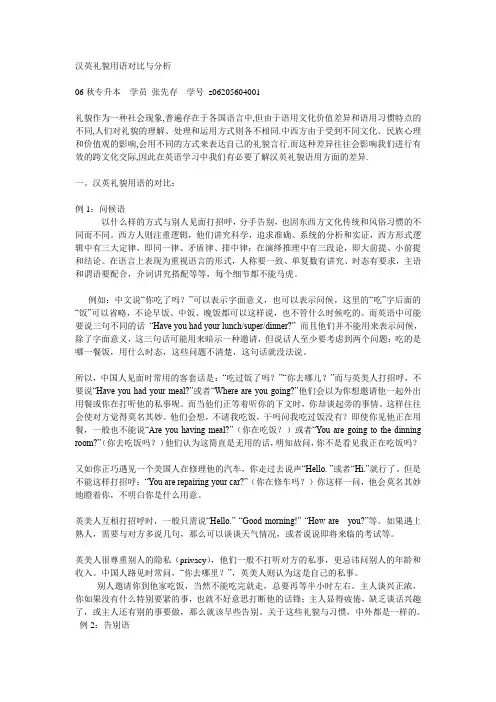
汉英礼貌用语对比与分析06秋专升本学员张先存学号z06205604001礼貌作为一种社会现象,普遍存在于各国语言中,但由于语用文化价值差异和语用习惯特点的不同,人们对礼貌的理解、处理和运用方式则各不相同.中西方由于受到不同文化、民族心理和价值观的影响,会用不同的方式来表达自己的礼貌言行.而这种差异往往会影响我们进行有效的跨文化交际,因此在英语学习中我们有必要了解汉英礼貌语用方面的差异.一。
汉英礼貌用语的对比:例1:问候语以什么样的方式与别人见面打招呼,分手告别,也因东西方文化传统和风俗习惯的不同而不同。
西方人则注重逻辑,他们讲究科学,追求准确、系统的分析和实证,西方形式逻辑中有三大定律,即同一律、矛盾律、排中律;在演绎推理中有三段论,即大前提、小前提和结论。
在语言上表现为重视语言的形式,人称要一致、单复数有讲究、时态有要求,主语和谓语要配合,介词讲究搭配等等,每个细节都不能马虎。
例如:中文说“你吃了吗?”可以表示字面意义,也可以表示问候,这里的“吃”字后面的“饭”可以省略,不论早饭、中饭、晚饭都可以这样说,也不管什么时候吃的。
而英语中可能要说三句不同的话“Have you had your lunch/super/dinner?” 而且他们并不能用来表示问候,除了字面意义,这三句话可能用来暗示一种邀请,但说话人至少要考虑到两个问题:吃的是哪一餐饭,用什么时态,这些问题不清楚,这句话就没法说。
所以,中国人见面时常用的客套话是:“吃过饭了吗?”“你去哪儿?”而与英美人打招呼,不要说“Have you had your meal?”或者“Where are you going?”他们会以为你想邀请他一起外出用餐或你在打听他的私事呢。
而当他们正等着听你的下文时,你却谈起旁的事情。
这样往往会使对方觉得莫名其妙。
他们会想,不请我吃饭,干吗问我吃过饭没有?即使你见他正在用餐,一般也不能说“Are you having meal?”(你在吃饭?)或者“You are going to the dinning room?”(你去吃饭吗?)他们认为这简直是无用的话,明知故问,你不是看见我正在吃饭吗?又如你正巧遇见一个美国人在修理他的汽车,你走过去说声“Hello. ”或者“Hi.”就行了。
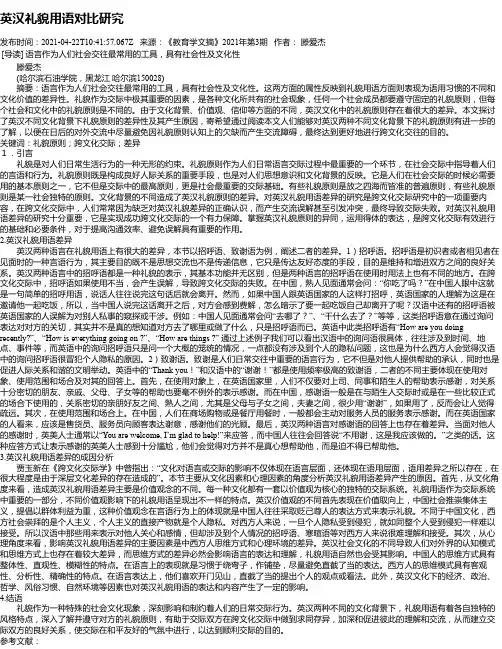
英汉礼貌用语对比研究发布时间:2021-04-22T10:41:57.067Z 来源:《教育学文摘》2021年第3期作者:滕爱杰[导读] 语言作为人们社会交往最常用的工具,具有社会性及文化性滕爱杰 (哈尔滨石油学院,黑龙江哈尔滨150028) 摘要:语言作为人们社会交往最常用的工具,具有社会性及文化性。
这两方面的属性反映到礼貌用语方面则表现为语用习惯的不同和文化价值的差异性。
礼貌作为交际中极其重要的因素,是各种文化所共有的社会现象,任何一个社会成员都要遵守固定的礼貌原则,但每个社会和文化中的礼貌原则是不同的。
由于文化背景、价值观、信仰等方面的不同,英汉文化中的礼貌原则存在着很大的差异。
本文探讨了英汉不同文化背景下礼貌原则的差异性及其产生原因,寄希望通过阅读本文人们能够对英汉两种不同文化背景下的礼貌原则有进一步的了解,以便在日后的对外交流中尽量避免因礼貌原则认知上的欠缺而产生交流障碍,最终达到更好地进行跨文化交往的目的。
关键词:礼貌原则;跨文化交际;差异1.引言礼貌是对人们日常生活行为的一种无形的约束。
礼貌原则作为人们日常语言交际过程中最重要的一个环节,在社会交际中指导着人们的言语和行为。
礼貌原则既是构成良好人际关系的重要手段,也是对人们思想意识和文化背景的反映。
它是人们在社会交际的时候必需要用的基本原则之一,它不但是交际中的最高原则,更是社会最重要的交际基础。
有些礼貌原则是放之四海而皆准的普遍原则,有些礼貌原则是某一社会独特的原则。
文化背景的不同造成了英汉礼貌原则的差异。
对英汉礼貌用语差异的研究是跨文化交际研究中的一项重要内容,在跨文化交际中,人们常常因为缺乏对英汉礼貌差异的正确认识,而产生交流误解甚至引发冲突,最终导致交际失败。
对英汉礼貌用语差异的研究十分重要,它是实现成功跨文化交际的一个有力保障。
掌握英汉礼貌原则的异同,运用得体的表达,是跨文化交际有效进行的基础和必要条件,对于提高沟通效率、避免误解具有重要的作用。
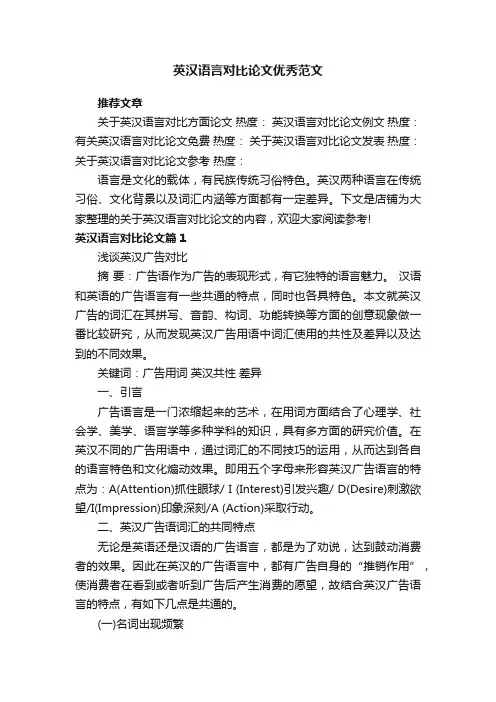
英汉语言对比论文优秀范文推荐文章关于英汉语言对比方面论文热度:英汉语言对比论文例文热度:有关英汉语言对比论文免费热度:关于英汉语言对比论文发表热度:关于英汉语言对比论文参考热度:语言是文化的载体,有民族传统习俗特色。
英汉两种语言在传统习俗、文化背景以及词汇内涵等方面都有一定差异。
下文是店铺为大家整理的关于英汉语言对比论文的内容,欢迎大家阅读参考!英汉语言对比论文篇1浅谈英汉广告对比摘要:广告语作为广告的表现形式,有它独特的语言魅力。
汉语和英语的广告语言有一些共通的特点,同时也各具特色。
本文就英汉广告的词汇在其拼写、音韵、构词、功能转换等方面的创意现象做一番比较研究,从而发现英汉广告用语中词汇使用的共性及差异以及达到的不同效果。
关键词:广告用词英汉共性差异一、引言广告语言是一门浓缩起来的艺术,在用词方面结合了心理学、社会学、美学、语言学等多种学科的知识,具有多方面的研究价值。
在英汉不同的广告用语中,通过词汇的不同技巧的运用,从而达到各自的语言特色和文化煽动效果。
即用五个字母来形容英汉广告语言的特点为:A(Attention)抓住眼球/ I (Interest)引发兴趣/ D(Desire)刺激欲望/I(Impression)印象深刻/A (Action)采取行动。
二、英汉广告语词汇的共同特点无论是英语还是汉语的广告语言,都是为了劝说,达到鼓动消费者的效果。
因此在英汉的广告语言中,都有广告自身的“推销作用”,使消费者在看到或者听到广告后产生消费的愿望,故结合英汉广告语言的特点,有如下几点是共通的。
(一)名词出现频繁由于名词是关键词,不可或缺。
所以,评价一则广告是否妙,是否能达到效果,主要在于是否恰当使用名词。
英汉广告中名词的选用都达到了绝妙的程度,突出了产品的特色、特点和作用。
如:There are many forces that motivate you to run, emotional stability,mental clarity,skinny jeans. Luckily once you motivate to lace up your shoes,the running part has a way of taking care of itself.(Reebok 跑鞋)其中 force,stability,clarity,jeans等从性能、材质的角度说明了该跑鞋的优秀。
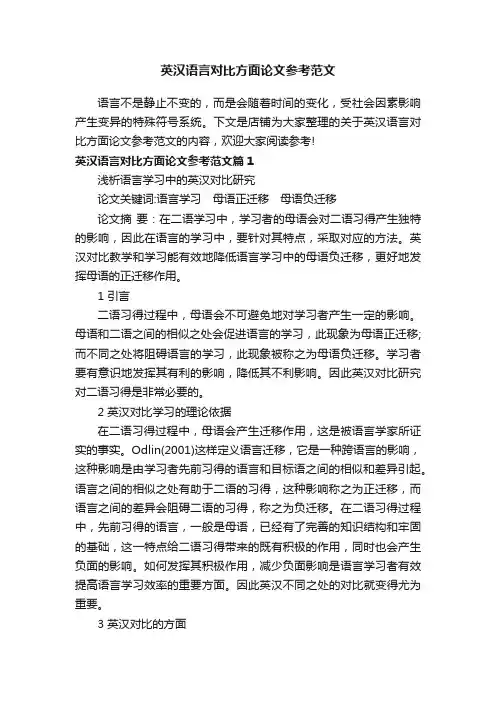
英汉语言对比方面论文参考范文语言不是静止不变的,而是会随着时间的变化,受社会因素影响产生变异的特殊符号系统。
下文是店铺为大家整理的关于英汉语言对比方面论文参考范文的内容,欢迎大家阅读参考!英汉语言对比方面论文参考范文篇1浅析语言学习中的英汉对比研究论文关键词:语言学习母语正迁移母语负迁移论文摘要:在二语学习中,学习者的母语会对二语习得产生独特的影响,因此在语言的学习中,要针对其特点,采取对应的方法。
英汉对比教学和学习能有效地降低语言学习中的母语负迁移,更好地发挥母语的正迁移作用。
1 引言二语习得过程中,母语会不可避免地对学习者产生一定的影响。
母语和二语之间的相似之处会促进语言的学习,此现象为母语正迁移;而不同之处将阻碍语言的学习,此现象被称之为母语负迁移。
学习者要有意识地发挥其有利的影响,降低其不利影响。
因此英汉对比研究对二语习得是非常必要的。
2 英汉对比学习的理论依据在二语习得过程中,母语会产生迁移作用,这是被语言学家所证实的事实。
Odlin(2001)这样定义语言迁移,它是一种跨语言的影响,这种影响是由学习者先前习得的语言和目标语之间的相似和差异引起。
语言之间的相似之处有助于二语的习得,这种影响称之为正迁移,而语言之间的差异会阻碍二语的习得,称之为负迁移。
在二语习得过程中,先前习得的语言,一般是母语,已经有了完善的知识结构和牢固的基础,这一特点给二语习得带来的既有积极的作用,同时也会产生负面的影响。
如何发挥其积极作用,减少负面影响是语言学习者有效提高语言学习效率的重要方面。
因此英汉不同之处的对比就变得尤为重要。
3 英汉对比的方面3.1 本体对比3.1.1 大小写方面在汉语中,我们不用考虑汉字的大小写,因为汉字不存在大小写的区别。
而英语的字母则不同,有大小写之分。
以汉语为母语的学习者,由于大小写概念不强,母语的不区分大小写的印象又很深,因此很容易在此方面出错。
英语中一个句子的首字母是必须要大写的,还有一些专有名词,如地名,人名,书名等。

本科毕业论文论文题目:浅谈中英礼貌语用差异指导老师:吴楠老师学生姓名:夏晓耿学号:W444609125610001院系:网络教育学院专业:英语教育写作批次:09年春季目录摘要Abstract引言中英礼貌用语差异具体描述(一)称呼语的差异(二)对待夸奖和祝贺的差异(三)道别用语的差异(四)日常寒暄语的差异(五)致谢语与道歉语的差异(六)餐桌用语的差异(七)差异产生的原因(八)如何减少跨文化交际礼貌语用失误结束语参考文献浅谈中英礼貌语用差异摘要本文从礼貌用语与中英文化的关系入手,从礼貌语用的角度对英汉两种语言进行了比较研究,通过简要描述中英日常交际中称呼语的差异、对待夸奖和祝贺的差异、道别用语的差异、日常寒暄语的差异、致谢与道歉语的差异、餐桌用语的差异分析出导致中英礼貌语用差异的原因,是由英汉两民族的价值观念、伦理道德观念、风俗习惯和思维方式的差异造成的,最后简要描述了如何减少跨文化交际礼貌语用失误,从中揭示出中西礼貌用语的差异性在跨文化交际中所具有的重要意义。
关键词:跨文化交际、礼貌用语、文化差异Talking about Differences of Polite Expressions inEastern and Western CultureXia xiaogengAbstract:Thisarticlet commences from the courtesy terminology and Chinese and English cultural relation and carried on to English-to-Chinese two kinds of languages than the research from courtesy angle used in language and passed a synopsis description the Chinese and English call the difference of language, treat and cry up in the daily social intercourse and the difference for congratulating and saying good-bye the difference of terminology and exchanging greeting the difference of language and sending thanks and apologizing the difference, dining table terminology of language everyday of difference analytical the reason that cause Chinese and English courtesy language use difference, is BE resulted in by English-to-Chinese difference of the concept of value, ethics moral concept and customs and habits and mode of thinking of two race, the synopsis finally described how to reduce the cross-cultural social intercourse courtesy language is used a mistake, announce to public from it in west the difference of courtesy terminology is in the cross-cultural social intercourse have of important meaning.Key word:cross-cultural communication;polite language;cultural difference引言礼貌是一种社会文化现象, 是人类交际的基本社会准则, 其目的是最大限度地削弱人类交际的潜在冲突和对抗, 改善人际关系, 促进人类交际。
本科生毕业设计(论文)封面(2016 届)论文(设计)题目作者学院、专业班级指导教师(职称)论文字数论文完成时间大学教务处制英语原创毕业论文参考选题(200个)一、论文说明本写作团队致力于英语毕业论文写作与辅导服务,精通前沿理论研究、仿真编程、数据图表制作,专业本科论文3000起,具体可以联系qq958035640。
下列所写题目均可写作。
部分题目已经写好原创。
二、原创论文参考题目1 论《白鲸》主角的悲剧实质2 文化语境维度下中餐菜名的英译研究3 《嘉莉妹妹》中赫斯特伍德人生悲剧4 文艺复兴及浪漫主义时期希腊神话对英国文学的影响5 浅析《远大前程》中皮普的个人抱负与自我完善6 论《大卫科波菲尔》中人物个性与时代背景的关系7 从《绝望主妇》各主角看美国家庭问题8 《水浒传》两个英译本中称谓语的翻译对比研究9 南北战争新思想在女性中的体现——浅析《小妇人》10 从女权主义视角分析《红字》中海斯特白兰的形象11 论修辞在广告语中的运用和翻译12 试析《我知道笼中鸟为何歌唱》的成长主题13 试述《亚当夏娃日记》的圣经情结14 A Comparison of Color Words Between Chinese and English Cultures15 (英语系经贸英语)电子商务bc运营模式——以亚马逊为例16 马克·吐温的短篇小说的文体分析17 从空间语言的角度分析中美隐私观念的差异18 从《了不起的盖茨比》看美国梦幻灭的必然性19 《乱世佳人》中的清教主义思想解析20 The Pervasive Agitation of Humbert in Lolita21 英语外贸信函的特点及翻译22 初中英语读写技能综合教学模式研究23 在幻想中回归童年──评析《爱丽丝漫游奇境记》24 析《狮子和宝石》中拉昆来失败的原因25 初中英语阅读技能教学26 斯嘉丽---一朵铿锵的玫瑰27 从关联理论角度谈电影《灰姑娘的故事》的字幕翻译28 伍尔夫的《达罗卫夫人》中的意识流和象征主义手法分析29 Beowulf: A Christianity Guided Pagan Epic30 查尔斯达尔内——《双城记》中一个内心充满矛盾的人物31 英汉形状类量词的隐喻认知分析32 浅谈经济全球化背景下的商务英语33 运用弗洛伊德人格理论解读《吸血鬼日记》中的吸血鬼形象34 《了不起的盖茨比》叙述者尼克分析35 对《灿烂千阳》中姐妹情谊的分析36 商务英语交流中委婉语的语用功能研究37 论童话《小王子》的象征创作38 论<<禁食与欢宴>>中乌玛的觉醒39 Which Woman is More Popular in Modern Society:A Comparative Study of Tess and Jane40 The Inharmonious Elements in The Old Man and the Sea from an Ecological Perspective41 凯瑟琳与苔丝悲剧命运的比较42 英语名的取名艺术43 Gender Difference in Daily English Conversation44 影视作品中的中英电话礼貌用语对比研究45 Euphemistic Expressions in Business Correspondences46 浅析《最蓝的眼睛》中的叙事艺术47 《德伯家的苔丝》中苔丝悲剧的分析48 卡勒德·胡赛尼《追风筝的人》中风筝的意向分析49 A Study on Cultural Shock in Intercultural Communication50 An Analysis of the Initiation Theme in The Child in Time51 浅析欧亨利短篇小说中的写作风格52 《简爱》中罗切斯特性格与命运研究53 造成苔丝人生悲剧的原因探析54 目的论视角下的广告翻译55 解析《爱玛》中女主人公的形象56 英语委婉语:礼貌视角下的有意不合作57 Oscar Wilde’s Aestheticism on The Picture of Dorian Gray58 Disillusionment of American Dream in death of a salesman59 从宗教建筑看中西文化差异60 功能对等视角下记者招待会古诗词翻译策略研究61 解读《爱玛》中的女性主体意识62 田纳西威廉姆斯《欲望号街车》中布兰奇的悲剧63 美国个人主义与中国集体主义的比较64 论英语广告的语言特点65 初中英语教学中课堂气氛与教学效果浅谈66 中医文化翻译中的归化和异化67 中西饮食文化对比研究68 A Comparison of the English Color Terms69 浅析广告英语中的隐喻70 英汉新词形成因素研究71 Reflections on the Inner Beauty of Jane Eyre72 阿加莎克里斯蒂侦探小说中的罪犯形象73 肯德基在中国的成功之道74 英汉关于“愤怒”隐喻的分析75 浅析政治外宣文本的翻译策略76 从《傲慢与偏见》和《理智与情感》探索简奥斯丁实用爱情观77 会话含义的语用初探78 论初中英语教学中的任务型教学法79 法律英语词汇的特点及其翻译80 《白鲸》中亚哈船长的人物形象解读81 试析海明威《丧钟为谁而鸣》中的人物形象82 海明威的生态意识在《老人与海》中的体现83 A Contrastive Analysis of Table Manners and Culture between China and Western Countries84 从跨文化交际看中西方时间观差异85 英汉诗歌中“月”意象的认知解读86 论《飘》与《傲慢与偏见》中女性追求幸福的不同方式87 傲慢与偏见中的婚姻观88 《爱玛》中身份和同辈的压力89 《了不起的盖茨比》中美国梦的破灭90 The Application of Cohesive Devices in Chinese-English Translation of Chinese Literary Works91 An Eco-analysis of The Yearling92 浅析隐藏在“面纱”之后的伯莎梅森93 从目的论看汽车广告的翻译策略94 解读《爱玛》中的女性主体意识95 论建构主义理论下初中英语教师的课堂角色定位96 英语影视作品中字幕翻译的幽默转化策略——以老友记为例97 官方语言中的中国英语分析--从目标人群接受性角度谈起98 英汉动物词汇的文化内涵对比及其翻译99 论英汉机器翻译中被动语态翻译的缺点100 An Analysis of Tragic Consciousness in A Farewell to Arms101 试析《伊坦弗洛美》中细娜的药品与乡村生活的不和谐性102 跨文化交际在英文电影赏析的应用103 爱神简论104 论《喜福会》中双重文化对母女关系的影响105 《玻璃动物园》中的逃避主义解读106 美国梦的迷失—解析《了不起的盖茨比》107 应用多媒体资源提高英语新闻听力108 中英商务口译中的文化差异及应对策略109 从托妮莫里森透析世纪黑人民族意识演变110 大学英语课堂教学中师生互动的重要性111 On the Disposal of Cultural Differences in the Translation112 An Analysis of the Distorted Male and Female Relationships in Sons and Lovers 113 简奥斯丁《理智与情感》中玛丽安和埃莉诺的成长研究114 英语词汇中的性别歧视115 象征主义手法在《白鲸》中的运用116 A Comparative Study of the Auspicious Culture in Wedding Custom between China and the West117 英语词汇中的性别歧视118 主位推进模式在语篇翻译中的应用119 从《哈克贝里﹒费恩历险记》看马克﹒吐温的幽默讽刺艺术120 A Study of Translation of English and Chinese Address Forms from Pragmatic Perspective121 《推销员之死》中的家庭问题研究122 《沙漠之花》的女性主义研究123 A Study on English and Chinese Euphemisms from the Perspective of Cultural Difference124125 生态哲人约翰斯坦贝克126 英语双关语语境分析及其翻译127 英语语境对词汇释义的制约作用128 A Study of Translation of English Advertising Language from the Aesthetic Perspective129 埃德加爱伦坡短篇小说的幽默性———以《同木乃伊的对话》为例130 《蝇王》中的象征131 The Application of TBLT to Reading-teaching in Junior Middle School132 顺句驱动原则下英汉同声传译中英语非动词转换为汉语动词的研究133 读者在文学文本多元解读中扮演的角色134 英文电影对英语专业学生词汇附带习得的影响135 基于语义场理论的英语词汇习得研究136 The Use of Body Language in Teaching137 露易莎梅奥尔科特《小妇人》中主要人物性格分析138 多媒体教学在中学英语教学中的利与弊139 中学生学习英语的焦虑感及对策140 浅析《德伯家的苔丝》中的苔丝悲剧的成因141 浅析《了不起的盖茨比》中的美国梦142 解读苔丝悲剧的成因143 写作的真“趣”——对《坎特伯雷故事集》的文体学分析144 评析杰克伦敦小说《荒野的呼唤》中巴克的象征意象145 On Michael Moore's Fahrenheit / From the Rhetoric Perspective 146 《傲慢与偏见》中英语反语的语用分析147 《到灯塔去》的象征性隐喻分析148 解读海明威的性属观149 在现实与理想间挣扎——论巴比特的无助与无奈150 试析《道连格雷的画像》中的伦理冲突151 网上英语聊天的会话结构特征152 对中西方传统节日之文化差异的研究153 论《呼啸山庄》中希斯克利夫的矛盾情感154 产品说明书的文体特征及其翻译155 论《追风筝的人》中父子关系的心理剖析156 从《瓦尔登湖》看梭罗的自然观157 英语汽车商标的翻译策略158 从关联理论看《博物馆奇妙夜》的字幕翻译159 英汉致使事件词汇化模式对比研究160 浅析《了不起的盖茨比》中象征主义的写作手法161 家庭生活中的瑞普凡温克尔162 语言变体的翻译——《哈克贝利费恩历险记》的两汉译本的比较163 从《简爱》两个译本看女性与男性语言使用的差别164 哈克贝利费恩人物性格分析165 “黑尔舍姆”教育尝试的失败—析石黑一雄小说《别让我走》166 中英文颜色词的文化内涵及翻译167 A Contrastive Study on Language Features of Chinese and English Proverbs168 论《汤姆琼斯》中流浪汉模式的继承与创新169 论政治文本翻译中的译者主体性170 从时代背景看《唐璜》中个人主义到人道主义的升华171 《远大前程》匹普与《了不起的盖茨比》盖茨比悲剧命运成因之比较172 《傲慢与偏见》中的婚姻观和中国后婚姻观的比较研究173 On the Translating Strategies of Children’s Literature Seen from the Translation of E.B.White’s Charlotte’s Web174 中西方茶文化映衬的文化差异175 Study on the Basic Principles of Legal English Translation176 《围城》英译本中文化负载词的翻译研究177 试析《儿子与情人》中保罗畸形的爱情观178 《红色英勇勋章》主人公刻画手法分析179 从价值观系统角度浅析中美商务谈判中的文化冲突180 An Analysis of Vanity Fair from the Perspective of Interpersonal Function181 《野性的呼唤》中的自然主义182 On the Fighting Spirit of Buck in The Call of The Wild183 海明威“冰山原理”在《永别了,武器》中的应用及对写作的指导意义184 《了不起的盖茨比》中盖茨比的人性弱点分析185 心灵探索之旅——析《瓦尔登湖》的主题186 浅析MSN交谈中的话语标记语187 接受美学指导下的电影字幕翻译——以《冰河世纪II》为例188 从男性角色解读《简爱》中的女性反抗意识189 小说《飘》中斯嘉丽的人物性格分析190 中美教育的比较及对比191 从文化差异角度来分析习语的翻译192 高中英语“后进生”产生的原因以及补差方法研究193 露易莎梅奥尔科特《小妇人》中的新女性独立精神194 无脸之殇——《英国病人》的后殖民指控分析195 海明威短篇小说的叙述艺术--以《一个明亮干净的地方》为例196 从功能对等角度看公示语的翻译197 A Chinese-English Translation of Public Signs Based on Nida's Fuctional Equivalence Theory198 高中英语阅读词汇障碍突破技巧的研究199 女权主义视野下的多丽丝莱辛200 英语广告中的礼貌原则。
A contrastive study of politeness principle in Chinese andEnglish culture汉英礼貌用语的对比研究【Abstract】With the development of society and culture, communicatio ns between people become more and more important. As we all know, dif ferent people hold different views about politeness and different cul tures may lead to pragmatic differences. Because of the cultural diff erences, sometimes what the Chinese people consider to be polite may not be true according to western culture. As a universal phenomenon, politeness is observed in every society, whose main functions are mai ntaining social order; maintaining friendly interpersonal relations; reducing conflicts and misunderstandings by means of polite speech ac ts so as to attain the aim of communication.To be polite, there are s ome principles to follow. This paper aims at describing these princip les, and also f ocusing on a comparative study on Politeness Principle in Chinese and English cultures.【Keyword】:Politeness Principle; difference; English culture; Chine se culture1. Overview of the Politeness PrincipleIn our daily life, we have to communicate with other people to get in formation, to gain knowledge about a topic or to reach a variety of g oals. To be successful, one has to follow some important strategies. Besides the rule--- the Cooperative Principle(abbrev. CP) of the Amer ican language philosopher and linguist, H.P. Grice, who thought that in order to make the conversation go on, we should obey some basic p rinciples, especially “Cooperative Principle”, bring ing about a gre at development in the concept of conversational implicate, there exis ts another concept --- the Politeness Principle (abbrev. PP), which h as above all been developed by Leech,a famous British linguist. In th e centre of this concept does not stand the information of a conversa tion, but the effect of what is said on the people.2.The basic contents of English and Chinese Politeness Principle2. 1.Theories of the Politeness PrincipleReferring to Searle`s categories of illocutionary acts, Leech points out a subdivision into negative and positive politeness. The negative politeness belongs eminently to the directive group, while positive politeness is dominant in the commissive and expressive group. He int roduces the term "impositives", too. Among those groups there existsa variety of theories and maxims which I’d like to deal with in the following essay.Following Grice’s example in dividing the CP, Leech divides the PP i nto six maxims, each consisting of two sub-maxims.(1) Tact Maxim (in impositives and commissives)a. Minimize cost to others;b. Maximize benefit to others.(2) Generosity Maxim (in impositives and commissives)a. Minimize benefit to self;b. Maximize cost to self.(3) Approbation Maxim (in expressives and assertives)a. Minimize dispraise of others;b. Maximize praise of others.(4)Modesty Maxim (in expressives and assertives)a. Minimize praise of self;b. Maximize dispraise of self.(5) Agreement Maxim (in assertives)a. Minimize disagreement between self and others;b. Maximize agreement between self and others.(6)Sympathy Maxim (in assertives)a. Minimize antipathy between self and others;b. Maximize sympathy between self and othe rs.”The PP’s function lies in that speakers should try to express themse lves in a polite way, in an indirect way and let the hearers sense th eir implication. The purpose of doing this is not to hurt others’ fe eling or make them lose face. So if there is the need of politeness, people in talking must observe PP. In observing the PP, speakers shou ld be always polite to others—minimize cost to other and maximize be nefit to other, so as to make a good impression on other and win the mutual respect.2.2. Chinese Politeness PrincipleWhen it comes to the Chinese scholars who have studied the Chinese Po liteness Principle and contributed significantly to the study of it, I would like to refer to Gu Yueguo , a professor of Beijing Foreign S tudies University. In his articles related to the study of politeness in modern Chinese, Prof. Gu has traced the origin of the motion of p oliteness in the Chinese culture, and has also formulated a different set of politeness maxims, which , he thinks, are more suitable to th e Chinese environment.Gu holds the view that there are basically four notions underlying th e Chinese conception of limao(礼貌),which are respectfulness, modest y, attitudinal warmth and refinement. And he concludes five maxims of limao(礼貌) according to Leech’s Politeness Principle:(1) Respectfulness Maxim: self’s positive appreciation or admirationof others concerning the lat ter’s face, social status, and so on.(2). Appellation Maxim: use proper appellation to address others.(3) Refinement Maxim: self’s demonstration of kindness, consideratio n, and hospitality to others.(4) Consistency Maxim: self’s behaviour to other which meets certain standards.(5) Virtue, Speech and Behaviour Maxim: on motivation, minimize other s’ cost and maximize other s’ benefit; on verbalism, maximize benef it self received and minimize cost self paid out.”3. Comparison between Politeness Principles in English and Chinese We can see that there are some common points of Politeness Principle between English and Chinese. But because of the different culture bac kgrounds, English and Chinese people have different viewpoints on pol iteness. Therefore, when using Politeness Principle, they will have s ome differences.3.1 The difference in Tact MaximMany scholars regard Tact Maxim as the upmost maxim of Politeness Pri nciple, for Tact Maxim, in English culture, is one of the most import ant and useful maxim. when showing some imperatives Tact Maxim is oft en used. But we often speak indirectly to show our politeness, the mo re indirectly we speak the more politeness we are. In English-speakin g countries individualism is considered to be of great value, which i s closely related with the history and culture. It usually refers to the freedom, right and independency of an individual. Therefore, impe rative action is considered as an intrusion to others, even between s uperior and subordinate, eldership and junior, teacher and student. S o they will obey Tact Maxim when they communicate with each other and avoid imposition.To Chinese, who have been overwhelmed by feudalism for more than a th ousand years, it is hard for them to understand individualism. Impera tive action is very common in China. When they say or do something th ey often consider other s’ status and strictly obey the rule of resp ecting elders. For instance:(1) Close the door.(2) Give me a cup of tea.In these two examples, both use imperative sentences. They are consid ered to be polite in China, but westerners do not think so.3.2. The difference in Appellation MaximIn China, either in formal or informal occasions, people often addres s others by using other’s occupation to show respect, when their soc ial positions are considered to be high or respectful, such as Profes sor Li, Teacher Zhang, Dean Sun and so on. If their social positions are considered to be low, such as barber, cleaner, technical worker, cook, plumber and most other people in service profession, people will often call them “shifu”(师傅) instead of their occupations to be polite. To the people in English-speaking countries, this is not the same. In formal situations, they often address people with high socia l position with their professions, such as Professor Green, Chairman Johnson, etc. But they never address people with “teacher or manage r”. In informal occasions, even a professor or a chairman prefers hi mself to be called with his given name to show intimacy to others. An d they tend to call others like this while a Chinese may feel unpleas ant to be called in such a term by unfamiliar person. For example, if a girl named “Yang Sitong (杨丝彤) ” is called as “Sitong(丝彤)” or “tong(彤)” by an ordinary friend, she will look on it as an insu lt.3.3. The difference in Modesty MaximAs for modesty, people all over the world hold the same view that to show modesty is a way to be polite. Leech’s Mo desty Maxim runs as “Minimize praise of self (Maximize dispraise of self)”. But how thi s maxim is adhered to in different cultures is very much a matter of degree. When being complimented, an English-speaking person would rea dily accept the compliment by s aying something like “Thank you” to show his appreciation of the praise, but a Chinese speaker would try to deny the truth of the compliment. They both are being modest and t hey both think they are behaving properly. Yet either of them would t hink the other is being polite. For instance:(1)A: Oh, how beautiful your dress is! B: Thank you.(2)A: Your English is very good. B: Not at all. My English is very poor.In examples (1) and (2) are the typical answers to praise of Engl ish and Chine se people. “The English speaker is being polite to the extent that by accepting and showing appreciation of the compliment; while the Chinese speaker ignoring the factuality of the compliment p aid to him. Because self-denigration has been at the core of the Chin ese notion of politeness for over two thousand years, the Chinese in order to show modesty will go to such lengths as to underrate what he himself has achieved and deny the truth of a complimentary remark.3.4. The difference in Sympathy MaximRespecting old people is the virtue of China, for old people in Chin a are the symbol of wisdom. During communication Chinese people often show respect and regard to old people. However, the situation in wes t is just the opposite. In English-speaking countries old people do n ot want to be considered as old. They will do everything in themselve s to prove that they are still young. People in English-speaking coun tries consider old as useless, so they don’t like to be treated as o ld and don’t like to accept other’s sympathy and help. So don’t of fer help too actively when communicate with people in English-speaking countries unless they ask for your help.4. Summary of the comparisonThe comparison of pragmatic differences of politeness between Chinese and English demonstrates that this politeness phenomenon is universa l in all cultures, but its expressions and implications are different from culture to culture. So a good understanding of pragmatic differ ences in politeness can undoubtedly contribute to the avoidance of pr agmatic failures in cross-cultural exchange so as to attain the goal in communication.Besides, grammatical mistakes are easy to be forgiven during intercul tural communication, but improper language use may cause embarrassmen ts and misunderstandings. Therefore, the comparative study of Politen ess Principle in Chinese and English cultures becomes more important. Meanwhile, to be familiar with the different cultural backgrounds an d to choose the right politeness maxims during communication are also very important and useful to intercultural communication.Reference:George Leec h. Principles of Pragmatics. (London & New York: Longman, 1997) 107Jenny Thomas, Meaning in Interaction (London & New York: Longman, 199 7) 155Li Tong. Pragmatic Differences in Politeness Compared between English and Chinese[J] Journal of Xinzhou Teachers University,2003,12,Hu Shangtian. A Probe into the Relation between the Cooperative Princ iple and the Politeness Principle[J].1997,7He Zhaoxiong. Study of Politeness in Chinese and English Culture[J]. 1995,5。
英汉语言对比论文例文(2)英汉语言对比论文例文篇3浅谈英汉语言对比与翻译摘要:作为翻译工作者,要产生高质量的译文,首先要了解原语和目的语各自的语言特点,译文要更符合目的语的语法规范和使用习惯,才能使译入语读者更自然地接受。
英语和汉语有着各自不同的语言特点,英语为综合-分析语,汉语为分析语; 英语重形合,汉语重意合;英语多被动,汉语多主动。
本文将从这几个方面对这两种语言进行分析和举例,希望对从事这方面工作的译者有所助益。
关键词:英汉语言对比翻译一、引言要做好两种语言间的翻译工作,就必须先对两种语言本身有所了解,对比分析是语言研究的重要手段之一,对不同语言进行对比分析不仅有利于语言交际,还有助于教学和翻译。
对比分析可以让人们进一步认识原语和目的语的特征,但真正意义上的对比分析,其兴起和流行是在20世纪50年代。
1957年美国语言学家Robert Lado出版了《跨文化语言学》(Linguistics Across Culture)一书,开启了现代应用对比语言学。
在我国则较晚,80年代对比语言学研究才得到语言学界的重视。
许多学者从宏观和微观两个方面对语言进行对比分析研究,他们既关注语言的内部形式和结构,又关注语言与社会文化之间的关系。
译者要产生高质量的译文,明白英汉两种语言各自的特点是前提。
二、综合语与分析语综合语的特征是运用语言的形态变化来表达语法关系。
Webster’s Ninth New Collegiate Dictionary将综合语定义为:A synthetic language is “char acterized by frequent and systematic use of inflected forms to express grammatical relationships”.德语、古英语、法语、拉丁语等都属于这类语言。
分析语的特征是不用形态变化而用词序及虚词来表达语法关系。
中英文礼貌用语对比研究发布时间:2021-07-07T14:24:12.427Z 来源:《教育学文摘》2021年12期作者:曾城[导读] 中国一直以来都是礼仪之邦,关于礼貌的相关词语较多。
在英汉翻译或者商务交流中,很多学习者会将中文用词和礼貌习惯带到与西方人交往的过程中,很容易会引起文化冲突或者交际障碍。
曾城湖南应用技术学院外国语学院, 湖南常德 415000摘要:中国一直以来都是礼仪之邦,关于礼貌的相关词语较多。
在英汉翻译或者商务交流中,很多学习者会将中文用词和礼貌习惯带到与西方人交往的过程中,很容易会引起文化冲突或者交际障碍。
本文主要通过参考国内外相关文献资料,分析理解权威人士的观点,研究中西方礼貌用语的目的在于通过在礼貌用语、表达方式、商务礼仪等方面在中英文的不同表现形式及差异,特别是语用差异,以及在不同文化背景下的礼貌用语的使用情况及如何做到正确使用礼貌用语,巧妙地转化礼貌用语,营造出更加轻松、自在的交流氛围,避免引发误解或者矛盾,以便促进不同文化间的沟通和交流。
关键词:礼貌用语;礼貌原则;商务礼仪;文化;差异对比第一章礼貌语用学研究综述一、礼貌语言和商务礼仪随着国际化的深度发展,商务方面的交往也越来越密切,在各种商务交往中逐渐形成了一套行为准则和指导方针,随着国际贸易的日益发展,协调人与社会之间的关系,使人与人相处,在尊重他人的前提下,遵守礼仪规则,按照礼仪规则其中的价值本身,没有成本,但却能创造价值,以你想象不到的方式盈利并使生意成功。
借用奥巴马访华的话说,这是一个“普遍原则”;用胡锦涛主席的话来说,商务礼仪是一种“软实力”。
二、合作原则和特殊会话含义合作原则含义:它是指沟通双方为了使谈话、合作顺利进行,为了达到共同的沟通目的而必须相互配合,共同遵守一些规则。
特殊会话含义:在实际的言语交际中,人们并不总是遵守“合作原则”,而是出于需要而故意违背合作原则。
而这种明显故意违反合作原则而产生的含义称为“特殊会话含义”。
(1)浅论英汉礼貌用语的差异及对英语教学的启示论文摘要:受不同文化、价值观等影响,英汉语言的礼貌用语也有所不同。
这种差异往往会影响跨文化交际的有效进行。
因此教师在英语教学中有必要使学生了解英汉礼貌用语的差异,以培养学生的跨文化意识,提高他们的跨文化交际能力。
论文关键词:礼貌用语差异跨文化意识1引言礼貌是各种文化普遍存在的一种社会现象。
礼貌用语是人们日常语言交际过程中的重要手段,不同的文化背景下有着不同的礼貌用语。
恰当使用礼貌用语,对调和及融洽人际关系起到了意想不到的作用。
随着对外交流的不断加强,跨文化交际也日益频繁,了解中西方礼貌用语的差异,无疑可以避免跨文化交际的失败。
2英汉礼貌用语的差异表现在不同场合,不同社会背景和文化的人会话时所采用的表达方式不尽相同,礼貌用语也有天壤之别。
下面主要从称呼语、称赞语、致谢、禁忌语与委婉语等方面来谈谈英汉礼貌用语的差异。
2.1称呼语不同的称呼语体现了不同的民族文化,反映了不同的文化取向、社会格局、人际关系等。
中国素以“礼仪之邦”甲天下,一直遵循“上下有礼,长幼有序”称呼原则,称呼繁杂;而西方崇尚民主自由,称呼简单明了。
中国文化主张尊老讲辈分,各种称呼五花八门。
上辈直系亲属的称呼就有“舅舅”、“伯父”、“叔父”、“姨父”、“姑父”、“舅妈”、“姨妈”、“姑妈”等。
同辈中则有“堂哥”、“堂弟”、“堂姐”、“堂妹”、“表哥”、“表弟”、“表姐”、“表妹”。
在英语国家中,由于不同的价值观念,亲属的称谓比较笼统且简单,上一辈中只有“uncle”、“aunt”,在同辈中也只有一个“cou sin”。
晚辈和长辈之间、同辈之间都可以直呼对方的名字,甚至对父母也可直呼其名。
而在中国传统教育中,孩子不能直呼父母、长辈的大名,学生不可直接叫老师的名字,下属不能直接叫上司的名字。
否则,就会被视作缺少家教、没有教养、不守规矩等。
在社会交往中,汉语称呼语可用两种表达式来概括:“姓氏+官衔或职务/先生/女士//小姐/老”和“老/小、+姓氏”,如“张局长”、“王先生”、“郑老”、“老陈”等。
Abstract This paper is a comparative study on the different use of polite language between English and Chinese. As an universal phenomenon, politeness exists in all kinds of cultures,which plays a vital role not only in maintaining friendly relationship between human beings but also in creating the harmonious atmosphere conversation. As English-speaking countries and China have different cultures, they use different ways to express their own polite words and deeds, and the different nationalities’ understanding of polite language always affects the effective cross-culture communication between them. What is more, it would causes unsuccessful cross-cultural communication. A comparative study of polite language between English and Chinese, will urge English learners to reduce the faults in using cross-cultural language, and will simultaneously achieve effective human communication through using appropriately polite expressions.
Key Words: polite language; communication; comparative study; cultural differences 中文摘要 礼貌是人们在频繁的交往中彼此表示尊重与友好的行为规范。礼貌现象存在于各种不同的文化之中,对于保持人们之间的友好关系,建立和谐的谈话气氛起着重要的作用。英汉国家由于受到不同文化的影响,会用不同的方式来表达自己的礼貌言行,而不同的民族对礼貌的理解各不同,这就往往影响英汉双方进行有效的跨文化交际,甚至会导致跨文化交际的失败。通过对比研究英汉礼貌用语的差异,会促使英语学习者在跨文化交际中减少语用失误,同时达到使用恰当的礼貌用语进行有效交际的目的。
关键词:礼貌用语;交际;比较研究;文化差异 Contents Abstract .......................................................................................................................... i 中文摘要 ........................................................................................................................ ii 1. Introduction ............................................................................................................... 1 1.1 Background .......................................................................................................................... 1 1.2 Aim and objectives ............................................................................................................... 1 1.3 Organization of the paper ..................................................................................................... 1 2. Literature Review ...................................................................................................... 2 3. A comparative Study of Polite Language Between English and Chinese ............. 4 3.1 Addressing form ................................................................................................................... 4 3.2 Greetings .............................................................................................................................. 5 3.3 Polite language for inviting .................................................................................................. 6 3.4 Polite language for apologizing and thanking ...................................................................... 7 3.5 The differences of private word in English and Chinese ...................................................... 8 4. The Investigation of Dominant Cultural Influence on Politeness and Strategies for Improving Cross-cultural Communication ......................................... 9 4.1 The dominant cultural patterns which influence polite language ......................................... 9 4.2 Strategies for improving cross-cultural communication....................................................... 9 5. Conclusion ................................................................................................................ 11 References ...................................................................................... 错误!未定义书签。 Acknowledgements ........................................................................ 错误!未定义书签。 1. Introduction 1.1 Background Studies on comparative study of polite language between English and Chinese have gain great attention at home and abroad, and thus large quantities of literature on the study of learning comparative study of polite language between English and Chinese were published. The main function of politeness expressions is to establish and maintain good interpersonal relationships. Due to the different culture between English and Chinese, the polite language is quite different. Contemporary, English has been as an important international language. As the economic developing very fast in China, it’ s international position is more and more important as well. So whether it is for English learners or foreigners, intercultural communication becomes more and more important. In order to avoid the verbal misunderstanding and failure in communication, ensure smooth communication, people should learn the differences polite language between English and Chinese. 1.2 Aim and objectives This study aims to find out the differences of polite language between English and Chinese in order to avoid verbal misunderstanding and failure in communication. This paper tries to analyze the cultural differences affect the polite language in English and Chinese, and points out that the comparative study will help us to reduce the pragmatic failure and achieve the cross-cultural communication. To be specific, this study attempts to answer the following three questions: (1)What is the purpose to analyze this study? (2) What causes the differences of polite language between English and Chinese? (3) What should we learn during this study? 1.3 Organization of the paper This paper is divided into five chapters. Chapter one serves as an overall introduction to the rationale and aim of the study. Chapter two reviews the definitions of politeness that have been proposed by scholars at home and abroad. Chapter three analyzes the differences in addressing, greeting, inviting, and apologizing and thanking by comparison. Chapter four analyzes the specific cultural assumptions, and put forward suggestions on how to improve the cross-cultural communication. Chapter five is devoted to the conclusion in which we find out the differences of polite language between English and Chinese in order to improve the cross-cultural communication.